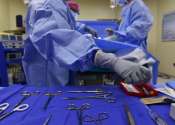People in poorer areas face lower stroke survival odds
People who have a stroke are more likely to die within a year if they live in more deprived areas according to new research from the University of Aberdeen.
Jul 8, 2025
0
0
People who have a stroke are more likely to die within a year if they live in more deprived areas according to new research from the University of Aberdeen.
Jul 8, 2025
0
0

For patients with atrial fibrillation, catheter ablation reduces the risk of ischemic stroke at more than 30 days, mortality, and heart failure hospitalization, while surgical ablation only reduces stroke risk, according ...
Jul 7, 2025
0
0

Exposure to alcohol in utero can have enduring health effects across the lifespan, including increased risks related to strokes in midlife, according to new research. The preclinical study found that fetal alcohol exposure ...
Jul 7, 2025
0
0

Tens of thousands of people suffer needless heart attacks and strokes every year because they aren't taking cholesterol-lowering drugs, a new study says.
Jul 2, 2025
0
0

Delirium affected 44% of critically ill patients in an Ohio medical center who were hospitalized after a recent stroke, according to new research published in the American Journal of Critical Care. Incidence rates were highest ...
Jul 1, 2025
0
0

Patients with atrial fibrillation who have experienced a stroke would benefit greatly from earlier treatment than is currently recommended in current UK guidelines, finds a new study led by UCL (University College London) ...
Jun 26, 2025
0
0

Combining neck surgery with intensive speech therapy is associated with greater improvements in a person's ability to communicate after a stroke than intensive speech therapy alone, finds a clinical trial published by The ...
Jun 25, 2025
0
0

Women who experience complications during pregnancy face a higher risk of stroke in the following decades, according to research published in the European Heart Journal.
Jun 23, 2025
0
0

Common viral respiratory infections such as COVID-19, respiratory syncytial virus (RSV) and influenza are linked to an increased short-term risk of stroke and heart attack in adults, new University of Melbourne research has ...
Jun 19, 2025
0
0

Winter is here, along with cold days and the inevitable seasonal surge in respiratory viruses.
Jun 19, 2025
0
0

A stroke, also known as a cerebrovascular accident (CVA), is the rapid loss of brain function(s) due to disturbance in the blood supply to the brain. This can be due to ischemia (lack of blood flow) caused by blockage (thrombosis, arterial embolism), or a hemorrhage (leakage of blood). As a result, the affected area of the brain cannot function, which might result in an inability to move one or more limbs on one side of the body, inability to understand or formulate speech, or an inability to see one side of the visual field.
A stroke is a medical emergency and can cause permanent neurological damage, complications, and death. It is the leading cause of adult disability in the United States and Europe and the second leading cause of death worldwide. Risk factors for stroke include old age, hypertension (high blood pressure), previous stroke or transient ischemic attack (TIA), diabetes, high cholesterol, cigarette smoking and atrial fibrillation. High blood pressure is the most important modifiable risk factor of stroke.
A silent stroke is a stroke that does not have any outward symptoms, and the patients are typically unaware they have suffered a stroke. Despite not causing identifiable symptoms, a silent stroke still causes damage to the brain, and places the patient at increased risk for both transient ischemic attack and major stroke in the future. Conversely, those who have suffered a major stroke are at risk of having silent strokes. In a broad study in 1998, more than 11 million people were estimated to have experienced a stroke in the United States. Approximately 770,000 of these strokes were symptomatic and 11 million were first-ever silent MRI infarcts or hemorrhages. Silent strokes typically cause lesions which are detected via the use of neuroimaging such as MRI. Silent strokes are estimated to occur at five times the rate of symptomatic strokes. The risk of silent stroke increases with age, but may also affect younger adults and children, especially those with acute anemia.
An ischemic stroke is occasionally treated in a hospital with thrombolysis (also known as a "clot buster"), and some hemorrhagic strokes benefit from neurosurgery. Treatment to recover any lost function is termed stroke rehabilitation, ideally in a stroke unit and involving health professions such as speech and language therapy, physical therapy and occupational therapy. Prevention of recurrence may involve the administration of antiplatelet drugs such as aspirin and dipyridamole, control and reduction of hypertension, and the use of statins. Selected patients may benefit from carotid endarterectomy and the use of anticoagulants.
This text uses material from Wikipedia licensed under CC BY-SA